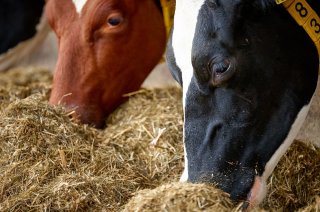
Dossier
Methane
Dutch livestock farmers have already made considerable strides towards a sustainable livestock sector. A critical task, as one of the climate agreement goals, is to further reduce the emission of methane (CH4). Wageningen University & Research (WUR) investigates solutions to reduce the emission of methane in the livestock sector.
Below, we answer five questions about methane
1. What is methane (CH4)? Is it a potent greenhouse gas?
Methane is a greenhouse gas that contributes to climate change. The three main greenhouse gases responsible for global warming are carbon dioxide (CO2), methane (CH4) and nitrous oxide (N2O). Methane, or CH4, is a colourless and odourless gas consisting of carbon and hydrogen. Methane is emitted through livestock farming, the cultivation of rice, landfills and natural gas mining. As a greenhouse gas, methane is 34 times more potent than CO2 and contributes approximately 20 per cent to the greenhouse effect.
- Unfortunately, your cookie settings do not allow videos to be displayed. - check your settings
2. Doesn’t methane disappear from the atmosphere?
While carbon dioxide and nitrous oxide remain in the atmosphere for hundreds of years, methane breaks down within decades. However, while present in the atmosphere, it has a significant temperature increasing effect. And, because methane continuously enters the atmosphere, its levels remain high. If we succeed in lowering the emission levels, the concentration of methane in the atmosphere will decrease rapidly. This would decrease the thickness of the figurative insulating layer of greenhouse gases, thus slowing down global warming.
3. What is the source of methane emission in livestock farming?
Methane is released during the breakdown of organic substances. In the digestive system of animals, for example, during their digestive process. Ruminants - such as cows, goats and sheep - in particular produce high levels of methane and are responsible for some three-quarters of the methane emissions in the livestock sector. They emit the gas from their lungs or stomach (through belching). This process is known as rumen fermentation.
The remaining 25 per cent of the methane emitted in in the livestock sector originates from the manure of cows and pigs. Stored slurry and manure contain compostable organic substances that produce biogas in the absence of oxygen (in liquid). This gas is made up of a little over 50% methane. The methane bubbles to the surface and into the atmosphere.
4. How much methane is emitted by livestock such as cows?
Of all the methane emitted in the Netherlands, two-thirds originate in the livestock sector. Other key sources are the use of fossil fuels and waste processing. WUR research focuses on reducing methane gas emissions from cows, since 77 per cent of all methane produced by the livestock sector originates from dairy and cattle farms. An additional 14 per cent is emitted by manure storage at pig farms, while other livestock such as chickens, goats, sheep and horses are responsible for the remaining 9 per cent.
5. How can we reduce methane emissions?
Emissions in the livestock sector are a serious issue. Despite many improvements over the last decades, reducing greenhouse gas emissions still requires much work. The farmer is a link in the agro-food chain, made up of suppliers, support services, processing businesses, supermarkets, and, finally, the consumer. Together, they form an interdependent chain in which each party must be addressed on its responsibility to increase the sustainability of the chain.
Four pathways to prevent and reduce methane emissions
WUR’s research provides insight into smart and economical solutions to prevent and reduce methane emissions. We transfer knowledge and research into practical measures for the livestock farmer. There are four pathways that offer solutions:
- Animal: studies on the difference between animals’ emissions based on genetics (nature) and animal management (nurture)
- Feed: studies on how feed and the rations thereof influence the emission of methane and ammonia
- Barn: studies on how adjustments to the barn, both of technical and managerial aspects, can help prevent methane and ammonia from forming
- Manure: studies on solutions in manure storage to prevent ammonia and methane from forming



